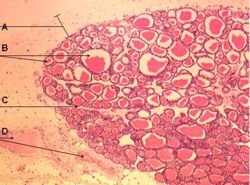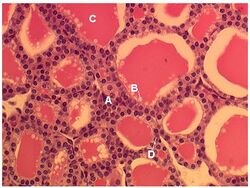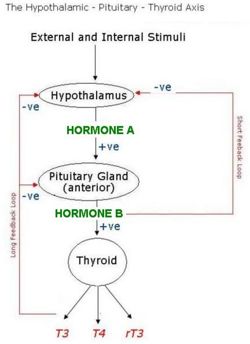| Question
|
Answer
|
Article
|
| Describe embryological origin of the Thyroid Gland.
|
- The thyroid gland is a downgrowth from the pharyngeal endoderm of the developing tongue.
|
Answer article
|
| Describe the location of the thyroid gland, it's closely associated structures and anatomical landmarks.
|
- The thyroid gland is adjacent to the cranial part of the trachea, closely associated with the Parathyroid Glands which may be within or close to the thyroid gland itself.
- Close to the thyroid gland are the Sternohyoid and Sternothyroid muscles, the recurrent laryngeal nerve and the carotid sheath.
|
Answer article
|
| Describe the blood supply and venous drainage of the Thyroid Gland.
|
- Supply = Cranial Thyroid Artery and Caudal Thyroid Artery
- Venous Drainage = Thyroid Vein (leading to Internal Jugular Vein).
|
Answer article
|
| The Thyroid gland consists of various sized follicles. What is the name of the cells which line the lumen of the follicles, and what is their function?
|
- Follicular Cells - these synthesize thyroglobulin in their golgi apparatus. Thyroglobulin is a glycoprotein consisting of 70 linked tyrosine molecules and is the source of thyroid hormones.
|
Answer article
|
| Label the following histological section:
|
- A = Connective Tissue Capsule
- B = Thyroid Follicles
- C = Connective Tissue Septum
- D = Blood Vessels in Capsule.
|
Answer Article
|
| Which Letter represents the location of the C-Cells of the Thyroid Gland, and what is their function?
|
- A represents the C Cells.
- The C-Cells (aka Parafollicular Cells) produce Calcitonin, a hormone which acts to lower the plasma calcium level.
|
Answer Article
|
| Define and describe the process of Iodide Trapping.
|
- Iodide trapping is the process by which Iodide molecules (I-) are concentrated in the colloid at a level up to 250x greater than the plasma level.
- The Na+/I- symport in the basal membrane of the follicular cells moves the iodine from the plasma, into the cell. From here is is transported into the colloid.
- The follicular cells and the pumps function in response to Thyroid Stimulating Hormone from the Pituitary Gland.
|
Answer Article
|
| Name the three hormones produced in the thyroid gland and describe how they are transported around the body?
|
- Hormones: Triiodothyronine (T3), Thyroxine (T4) and Reverse T3.
- Thyroid hormones are lipid soluble, thus require a binding protein in order to travel in the bloodstream. Thyroid Binding Globulin caries 70-80% of the circulating hormone, with Thyroxine Binding Pre-Albumin, and Albumin carrying the remainder.
|
Answer article
|
| What are Hormone A and Hormone B in this schematic diagram of the Hypothalamic - Pituitary - Thyroid Axis:
|
- Hormone A = TRH - Thyrotropin Releasing Hormone
- Hormone B = TSH - Thyroid Stimulating Hormone (Thyrotropin)
|
Answer article
|
Decribe the effects that T3 and T4 have on the following systems/physiological mechanisms:
- Musculoskeletal System
- Carbohydrate metabolism
- Fat metabolism
- Basal Metabolic Rate
- Cardiovascular System
- Nervous System
- Alimentary System
|
- Musculoskeletal system - Thyroid hormone promotes bone growth
- Carbohydrate metabolism - Thyroid hormone stimulates glucose uptake, glycolysis, gluconeogenesis
- Fat metabolism - Thyroid hormone mobilises lipids from adipose stores. Accelerates oxidation of lipids to produce energy (occurs within mitochondria). Increases size and number of mitochondria.
- Basal Metabolic Rate (BMR) - Thyroid hormone causes and increase in BMR in all tissues except brain, spleen, gonads. Results in increased heat production, increased oxygen consumption.
- Cardiovascular actions - Thyroid hormone increases Cardiac output, heart rate and contractility.
- Nervous system - thyroid hormones are required for development of this system. They also enhance the sympathetic nervous system (by increasing epinephrine receptors).
- Alimentary System - Thyroid hormone increases appetite and feed intake, increases secretion of pancreatic enzymes and increases motility.
|
Answer article
|


